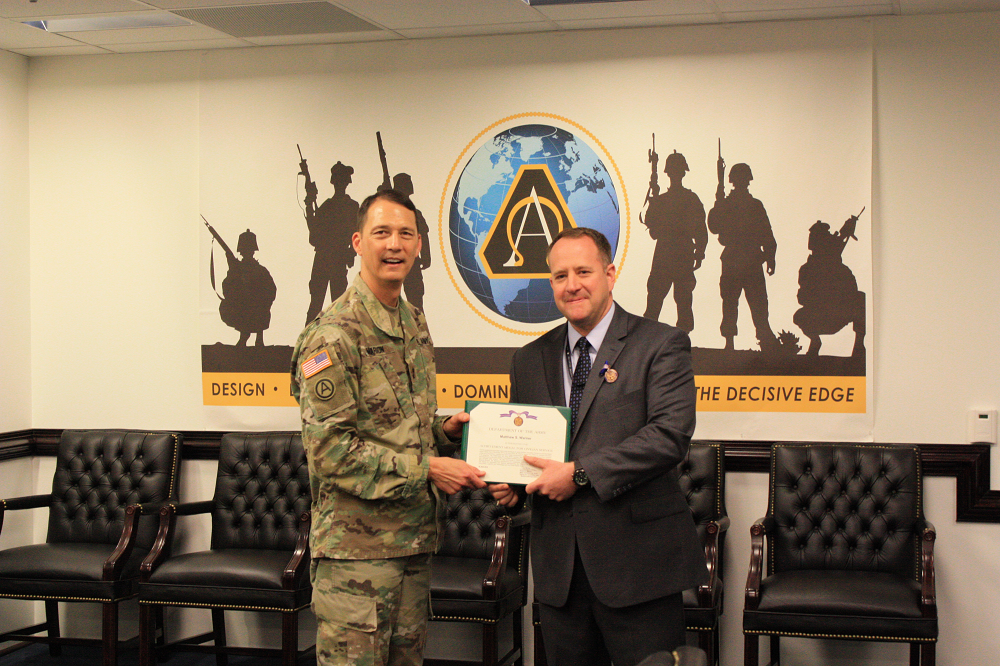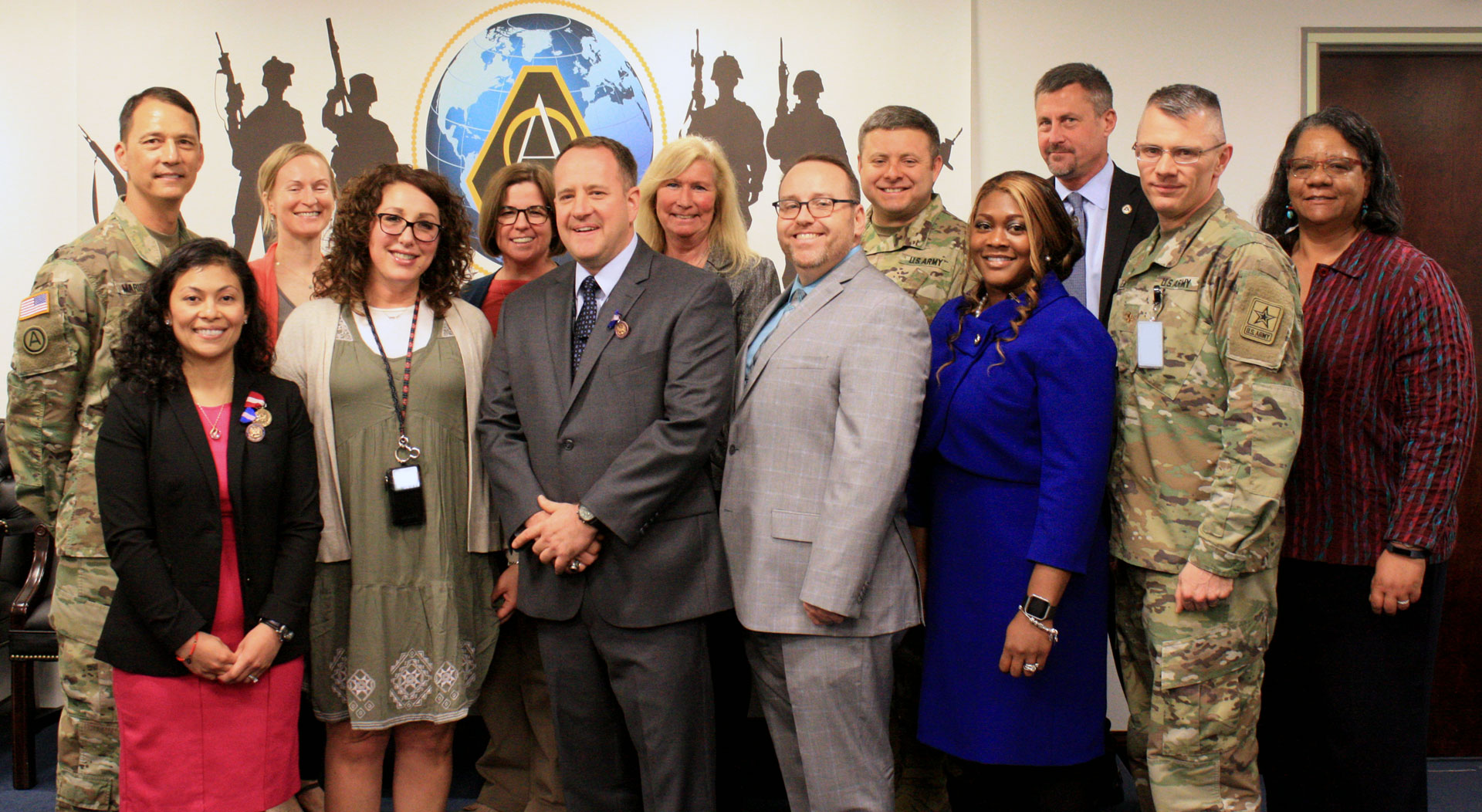
COMMAND/ORGANIZATION: Acquisition Reporting and Assessments Office, ASA(ALT)
TITLE: ASA(ALT) action officer
YEARS OF SERVICE IN WORKFORCE: 9
YEARS OF MILITARY SERVICE: 21 (11 years active duty; 10 years Army Reserve)
DAWIA CERTIFICATIONS: Level III in program management
EDUCATION: Master of strategic studies, U.S. Army War College; master of public policy analysis, University of Missouri; MBA and BBA, Western Michigan University
AWARDS: Army Meritorious Service Medal (3); Civilian Achievement Medal (3)
Bringing clarity to the mission
by Ms. Susan L. Follett
It has been a busy few years for Matthew Warner: As a fellow in the Competitive Development Group/Army Acquisition Fellowship program, he has completed several broadening assignments, including rotations as a project officer, source selection board chair and assistant program manager. The assignments reflect the program’s overall goal to expose participants to the range of responsibilities and skills that an acquisition professional at the GS-14 level or above needs to successfully support the Army’s acquisition mission.
“My greatest satisfaction from the program has been the broadening experience that the rotations provide,” he said, noting that the program encourages participants to seek rotations that are outside of their comfort zone. Warner worked with his mentor, Mike Cadieux, now acting deputy project manager for the Joint Light Tactical Vehicle Program and formerly the acting deputy program executive officer for Combat Support and Combat Service Support (PEO CS&CSS), to map out assignments that augmented his program manager background with exposure to new areas.
Warner’s most recent assignment, which began in November, supported the acquisition Reporting and Assessments Office in the Office of the Assistant Secretary of the Army for Acquisition, Logistics and Technology (ASA(ALT)), where he monitored changes to the National Defense Authorization Act and Title 10 and revised implementation guidance that affects DA system coordinators (DASCs) and the PEOs they represent. (The office was created earlier this year with the merger of the Army Systems Acquisition Review Council and the Office of Performance Assessments and Root Cause Analyses.) Additionally, he worked with experts in the areas of better buying power and should-cost management to update implementation guidance for annual reporting requirements and to staff several policy changes that affect the Defense Acquisition System, from senior leaders all the way up to the chief of staff of the Army.
While his official position was action officer, Warner noted that “jack of all trades” is a more appropriate title. “From the DASCs to the secretariat, there are no shortages of taskers that force me and my co-workers out of our comfort zones into areas where we may have no prior expertise,” he said. “Taskers often require multiple iterations of horizontal communication with experts, and in many cases, there are no process owners, only an enterprise-wide effort to tie it all together.”
Warner has been in acquisition since 2009, following 11 years as active-duty Army and two years with Jacobs Engineering Group Inc., supporting the Mine Resistant Ambush Protected (MRAP) Vehicle program within PEO CS&CSS. “When I left the Army, I had just completed a 15-month stint commanding a combat engineer company in Iraq, where I was responsible for route clearance on parts of Route Tampa in Baghdad, a supply route that runs from Baghdad to Fallujah. I knew firsthand we needed better route clearance equipment, and I wanted to continue to serve the Army as I transitioned from active duty.”

Warner receives the Achievement Medal for Civilian Service May 3, 2018, from Brig. Gen. Robert Marion, deputy for acquisition and systems management within ASA(ALT). Photo by Maj. Thomas Kralyn, ASA(ALT) Acquisition Reporting and Assessments Office
He has been with PEO CS&CSS ever since, as the MRAP RG-31 program transitioned from a joint operational needs statement program to a program of record. (The RG-31 is a variation on the basic MRAP design.) He has overseen projects all along the system’s life cycle, including design, production, fielding, engineering change proposals and block upgrades. Warner, who is a member of the Army Reserve, noted that his military background provides a unique perspective to his work. “As a Soldier, I understand the mission and what it supports. I know what warfighters need and why they need it, and since I’ve been there, I also understand the urgency.”
He entered the Competitive Development Group/Army Acquisition Fellowship program in 2015. “I was surprised by how willing the program mentors and even the supervisors were to allow us to define our own work effort. There are no expectations about the left and right limits of the assignments,” he said. Fellows “are required to solve unstructured problems and to network across the enterprise. The program is really geared toward leadership and individual initiative.”
During his second rotation, for example, he served as a project officer in the Project Manager for Transportation Systems (PM TS) within PEO CS&CSS. “The problem I addressed—declining trailer readiness—had no routine solutions and wasn’t well-defined.” Warner created and led an enterprise-wide integrated product team that evaluated the entire PM TS portfolio, eventually contracting for a capabilities-based assessment of the heavy trailer portfolio that would identify what an armored brigade combat team would need in 2025.
“That rotation was definitely the most impactful one I had throughout the program,” he said. “It gave me a better idea of what goes into a capabilities-based assessment and how requirements are developed. Before the assignment, I had only worked on programs that were post-milestone C; I had a limited exposure to what went on before milestone C, and how complicated the requirements development process can be.”

Warner, shown here with his team from ASA(ALT), received the Achievement Medal for Civilian Service May 3, 2018, from Brig. Gen. Robert Marion, ASA(ALT)) deputy for acquisition and systems management. Photo by Maj. Thomas Kralyn, ASA(ALT) Acquisition Reporting and Assessments Office
The program also gave Warner the opportunity to learn how to create structure out of ambiguity. “The assignments I was placed in did not have firm boundaries, processes or working networks. It took legwork to establish working teams and systems and to stand up structure where none existed,” he said, adding that constant communication and solid problem-solving methodology were factors in his success.
“Whether using the Six Sigma DMAIC [define, measure, analyze, improve and control] approach, the military decision-making process or conceptual thinking, the key takeaway is that white-boarding the problem to an acceptable level of detail and building a team of stakeholders to solve it is the only way to slow a moving target,” said Warner. “It’s also the only way to break the cross-functional stovepipes that prevent getting at root causes.”
Warner has this advice for potential Competitive Development Group/Army Acquisition Fellowship participants: Do what he did, only backward. “My only regret is that I wasn’t able to front-load my 179-day rotational assignment at the Pentagon. … Make a solid attempt to start that first. The perspective gained from exposure to the acquisition assessment and reporting process in the ASA(ALT) front offices in the Pentagon is an advantage that will aid other CDG rotations.”
“Faces of the Force” is an online series highlighting members of the Army Acquisition Workforce through the power of individual stories. Profiles are produced by the U.S. Army Acquisition Support Center Communication and Support Branch, working closely with public affairs officers to feature Soldiers and civilians serving in various AL&T disciplines. For more information, or to nominate someone, please contact 703-664-5635.
Subscribe to Army AL&T News, the premier online news source for the Acquisition, Logistics, and Technology (AL&T) Workforce.







